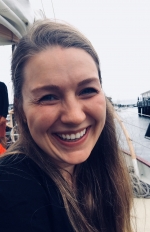
 Lily is a second-year student at Tuck and is pursuing her MBA alongside an MPH from The Dartmouth Institute. Prior to Tuck, Lily supported a variety of healthcare clients as a commercial strategy consultant at Booz Allen Hamilton in Washington, D.C. She obtained her B.A. from the College of William and Mary where she majored in Political Science.
Lily is a second-year student at Tuck and is pursuing her MBA alongside an MPH from The Dartmouth Institute. Prior to Tuck, Lily supported a variety of healthcare clients as a commercial strategy consultant at Booz Allen Hamilton in Washington, D.C. She obtained her B.A. from the College of William and Mary where she majored in Political Science.
This summer, I worked in the Strategic Planning group at the Dartmouth-Hitchcock Health System. Dartmouth-Hitchcock Health (D-HH) serves a large swathe of New Hampshire and Vermont that includes some of the state’s most vulnerable regions and citizens. Within that service area, Dartmouth Hitchcock Medical Center (DHMC) provides tertiary and quaternary care to many people with serious conditions that cannot be treated by smaller local hospitals. These local hospitals play a critical role in delivering care to patients in some of the most rural parts of the state, but financial pressures have, in some cases, kicked off a vicious cycle of cuts to specialties and programs that bring these important community institutions closer to the brink of collapse. To keep hyper-rural hospitals and their communities alive and well, D-HH decided to develop a strategic plan to strengthen the rural health network as a component of a broader strategic planning process encompassing eight focus areas.
I helped Chief Strategy Officer Steve LeBlanc lead a group of executives drawn from each of the individual entities within the D-HH system through a strategic planning process that began with the identification of goals and critical questions and ended with a set of recommended services to strengthen capacity across rural institutions. To support the recommendation generation process, I worked with a small team to assess current and anticipated health and health care needs across eight key regions in the D-HH service area. We then assessed the financial stability of over twenty hospitals alongside referral patterns to identify vulnerable institutions and their role within the broader rural health network. Through a series of accompanying working sessions with the executive group we explored the gathered data and analysis and built a menu of potential services and partnerships to support vulnerable regions. Outside of the rural markets workgroup, I also helped define and develop materials to guide the shared strategic planning process used by each of the eight workgroups supporting the organization’s focus areas. Helping to define the process then operationalizing it through the rural markets workgroup taught me a lot about the importance of clarity and consistency in helping a diverse group to move towards a shared goal.
While the issues were fascinating enough to me on their own, I was most inspired by the working sessions with D-HH executives. Each of our conversations began and ended with a shared goal to make health care better. Faced with such extreme financial and operational pressures, it would be so easy to focus inward and forget their commitment to the broader region. Instead, these leaders were open, forward-looking, and compassionate, realizing that a rising tide lifts all boats. I deeply enjoyed the opportunity to build my skills as a researcher, and facilitator and I look forward to re-joining D-HH after Tuck to keep making health care better.